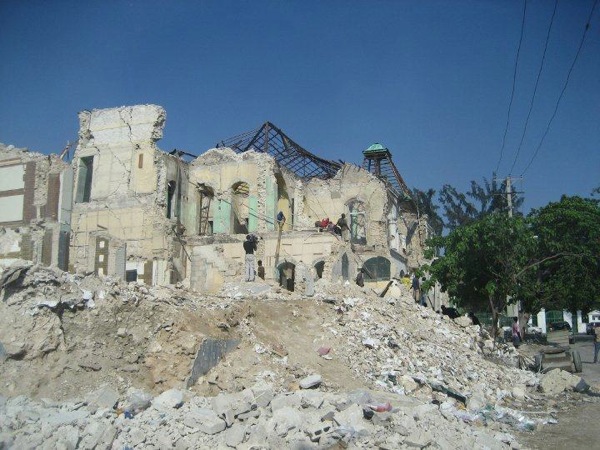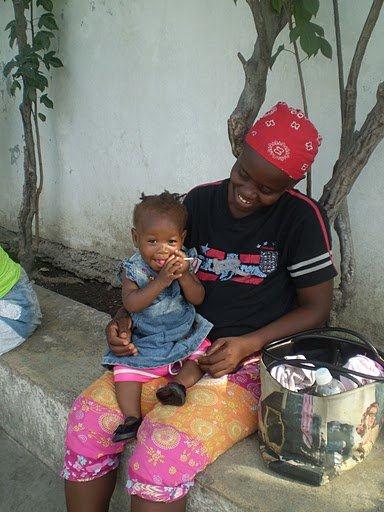To contact us Click
HERE

For most of my career, I've been fortunate enough to work with clinicians who heal and who care. Who bring skill and experience, and a frequently unquenchable compassion, into situations that many of the rest of us would do nearly anything to avoid. I may be inclined to exit... while they rush in.
Meet Barbara, a nurse manager from the Visiting Nurse Association of Boston. And here are a few of her photos of her native Haiti. Idyllic and beautiful, as in the sunlit bay above. Tragic and devastating, as in what follows.
Tuesday, January 12, 2010. A catastrophic magnitude 7.0 earthquake with an epicenter only 25 kilometers west of capital city, Port-au-Prince. Ultimately... 316,000 dead. 300,000 injured. 1,000,000 homeless.
And Barbara rushed in.

Here's her story... from the beginning.
Barbara grew up in Carrefour, a suburb of Port-au-Prince, with her mom, a teacher, and dad, an owner of an auto repair business, and brother and sister. It was a happy, largely uneventful time... until her father became sick. Among his ailments, Barbara's father also suffered from decubitius skin ulcers, which then (and even still today in Haiti) were poorly understood. Barbara, then 13 years old, remembers being angry when her father, a proud man who resisted family pressure to move to the United States, told her "not to worry" and that he would be around for "another ten years". Unfortunately, that was not to be the case.
At the age of 16, Barbara and her remaining family members moved to Florida and then eventually to Cambridge, Massachusetts. Barbara and her sister, Beatrice, held a variety of jobs and when Barbara decided she wanted to become a nurse, Beatrice, then a medical assistant, helped her to pay for the training. When Barbara completed nursing school, she began working and then helped to finance Beatrice's nursing education. Barbara continued on to earn her bachelor's degree and is now studying for a master's in health care administration.
Barbara remembers well that day in January, 2010. Reports of an earthquake began surfacing, with no one fully aware of its magnitude or impact. Beatrice called Barbara and gave her an update. It was far worse than expected. Far worse.

Barbara recalls: "We were looking at the news. We couldn't believe it. Nobody knew what was happening. We started calling our family there but no lines were open. We were so worried. We couldn't sleep. We tried calling the UN but couldn't get through. We just didn't know what to do. I was desperate..."
The overwhelming emotion was helplessness. "People there were dying and I thought, I'm a nurse. I have to help." Partners in Health, an organization dedicated to improving the quality and access to health care services in poor and developing areas, called Beatrice on Saturday and asked to deploy her to Haiti on the following Monday. A month later, Barbara's call came.
It was a two week assignment. The lead time was limited. According to Barbara, "you just pack your bag and go."
She recalls departing the airport in Haiti. She remembers looking around at the rubble, the devastation, the places where buildings once stood. "It was tough to see a country you left and is no longer there."
Barbara was stationed at the General Hospital in Port-au-Prince. "Once you got there, the gate was closed and you couldn't leave." And once there, she and her companions worked for 10 days straight, during 7PM to 7AM shifts. Barbara remembers being struck when she saw the former sight of a nursing school next to the hospital which she had seen as a child. "It was no longer there. It was completely flat. I wondered how many people were trapped underneath."
After a quick orientation from the physician-in-charge, Barbara was given a brief tour and was immediately "put to work." She described the first day as "one of the worst days of my life. There were 300 to 400 patients there all needing care... from TB to fractures to missing limbs to wounds... to people who were just dying. Just name it - it was right there looking at you..."
When asked how she responded to that, Barbara describes: "You start to work. Your forget about everything else. You just tried to save everyone you could. You just do whatever you can."

She remembers one young girl at the hospital. She had lost nine members of her family in the tragedy. "She was so thin. You could see only bones. She would not eat or drink... and she never spoke... except at night, she would scream out the names of her family who were now lost to her. I remember seeing a lady who stayed with her. She was from the local church and she slept on the floor, giving the girl a sip of water." Despite their efforts, the patient passed away.
Another patient, a 27 year old woman with renal failure and high blood pressure, was experiencing significant physical and emotional stress. Barbara knew the patient needed oxygen and fast, so she ran down the hall looking for a tank. A simple tank of oxygen. Plentiful in every hospital where Barbara has worked, but scarce in Port-au-Prince's General Hospital. Barbara called out: "This girl's going to die, her heart's going to give out soon... "... and remembers seeing the desperate look in the woman's eyes. The patient said to Barbara: "Please don't leave me. If you leave me, they're going to let me die." Barbara knew she was right.
The patient eventually received the oxygen and the vital dialysis she required and lived.
There was also an older woman patient who "could have been my mother." She had two wounds in her lower legs; "it looked to be a diabetic ulcer". Barbara watched this patient fade from an amiable, even joking, favorite among the nurses, to one who became more and more ill and despondent. At one point, she had no clothing or even sheets, leaving one of the nurses to donate some of her own clothing to the patient. The patient died, alone and in pain. Per Barbara, "there was no reason for her to die that way..."
Barbara looks back at the experience and feels that: "We didn't do enough. There's so much more to do there. And it's not over there. It's terrible what's happening in the tent cities there now. It's just horrible still... but I want to go back."
When asked why she wants to return, Barbara lowered her eyes and said, simply and solemnly: "It's what we do... we are nurses..."
If you're interested in learning more about Partners in Health, please click here.
If you'd like to help, click here.
Posted by Rey
 There are a select number of healthcare marketing events every year that I can't wait to attend: the Spring Conference of the New England Society for Healthcare Communications, the Fall Conference of the Carolinas Society for Healthcare Public Relations & Marketing, the Forum for Healthcare Strategy's Healthcare Marketing Summit, and the annual conference of the Society for Healthcare Strategy and Market Development (SHSMD). Each of these gathering is a highpoint of my year.
There are a select number of healthcare marketing events every year that I can't wait to attend: the Spring Conference of the New England Society for Healthcare Communications, the Fall Conference of the Carolinas Society for Healthcare Public Relations & Marketing, the Forum for Healthcare Strategy's Healthcare Marketing Summit, and the annual conference of the Society for Healthcare Strategy and Market Development (SHSMD). Each of these gathering is a highpoint of my year. So I can't tell you how disappointed I am to be missing this year's SHSMD Conference. Although I had every intention of being there (booked a flight and a hotel room), on Sunday I made up my mind that life has gotten too complicated and that I need to be at home with my family. When I finally came to that conclusion, it put my mind at ease. What a relief. It shouldn't have been a hard decision at all. Family comes first. There will be other conferences. But it was still a hard decision. This conference only happens once a year and I had planned for it. It provides an important marketing platform for my company. For me, it was hard to let go. At first I debated flying up for the day on Wednesday and Thursday and flying home each evening to be with my family. I know, crazy idea. I kept coming up with possibilities, but none of them were realistic.
So I can't tell you how disappointed I am to be missing this year's SHSMD Conference. Although I had every intention of being there (booked a flight and a hotel room), on Sunday I made up my mind that life has gotten too complicated and that I need to be at home with my family. When I finally came to that conclusion, it put my mind at ease. What a relief. It shouldn't have been a hard decision at all. Family comes first. There will be other conferences. But it was still a hard decision. This conference only happens once a year and I had planned for it. It provides an important marketing platform for my company. For me, it was hard to let go. At first I debated flying up for the day on Wednesday and Thursday and flying home each evening to be with my family. I know, crazy idea. I kept coming up with possibilities, but none of them were realistic. One Caveat: Before reading this post, please know that I am not a cancer patient, nor am I a cancer survivor. When it comes to the whole Pink Movement, I defer to those on the front lines - cancer patients and survivors. If you'd like the perspective of one amazing cancer advocate and survivor, check out this blog post by Jody Schoger titled "Women with Cancer: Redefining Pink." I follow Jody on Twitter and recommend that you do the same. She is a writer, blogger and a self-proclaimed optimist. As a cancer survivor, I give her views on Pink a whole lot more credibility than my own. That said, within this blog post I will share with you my thoughts on how some businesses approach Pink. I know I am treading into dangerous territory, but I'm going there anyway.
One Caveat: Before reading this post, please know that I am not a cancer patient, nor am I a cancer survivor. When it comes to the whole Pink Movement, I defer to those on the front lines - cancer patients and survivors. If you'd like the perspective of one amazing cancer advocate and survivor, check out this blog post by Jody Schoger titled "Women with Cancer: Redefining Pink." I follow Jody on Twitter and recommend that you do the same. She is a writer, blogger and a self-proclaimed optimist. As a cancer survivor, I give her views on Pink a whole lot more credibility than my own. That said, within this blog post I will share with you my thoughts on how some businesses approach Pink. I know I am treading into dangerous territory, but I'm going there anyway. Here's my problem. I already support a few cancer related organizations with donations each year. With that in mind, I'd prefer not to get a sales pitch about supporting a breast cancer charity when I walk up to the counter to buy my skinny Latte at my local coffee shop. On the most basic level, I don't want to be put in the position of having to say "no thank you" to the lady behind the counter wearing the crazy pink hat. I don't want to have a conversation with my Barista about my views on philanthropy and my history of giving. That's what happens at my local Caribou Coffee establishment. During October and part of November, Caribou Coffee Company sells its Amy's Blend collection in honor of their Roastmaster Amy Erickson who passed away from breast cancer. Amy was a real person who lost her tragically lost her life to breast cancer. That is real and should not get lost in this story about Caribou Coffee. When a customer purchases Amy's Blend products, Caribou donates 10% of sales to CancerCare - a non-profit organization that provides counseling and financial assistance to people dealing with cancer. Based on the most recent annual report I could access online, CancerCare spends $0.17 of every dollar it receives on fundraising, management and general expenses (overhead). The rest goes to support its programs. It gets three stars from Charity Navigator. So it looks like a good cause - and a less controversial choice than the Susan G. Komen Foundation.
Here's my problem. I already support a few cancer related organizations with donations each year. With that in mind, I'd prefer not to get a sales pitch about supporting a breast cancer charity when I walk up to the counter to buy my skinny Latte at my local coffee shop. On the most basic level, I don't want to be put in the position of having to say "no thank you" to the lady behind the counter wearing the crazy pink hat. I don't want to have a conversation with my Barista about my views on philanthropy and my history of giving. That's what happens at my local Caribou Coffee establishment. During October and part of November, Caribou Coffee Company sells its Amy's Blend collection in honor of their Roastmaster Amy Erickson who passed away from breast cancer. Amy was a real person who lost her tragically lost her life to breast cancer. That is real and should not get lost in this story about Caribou Coffee. When a customer purchases Amy's Blend products, Caribou donates 10% of sales to CancerCare - a non-profit organization that provides counseling and financial assistance to people dealing with cancer. Based on the most recent annual report I could access online, CancerCare spends $0.17 of every dollar it receives on fundraising, management and general expenses (overhead). The rest goes to support its programs. It gets three stars from Charity Navigator. So it looks like a good cause - and a less controversial choice than the Susan G. Komen Foundation.




 improve cancer testing and diagnostics. The ClearCell System finds circulating tumor cells that have attached to a cancerous tumor. This got buried in my mailbox so I’m getting it out today. I have written about several of the devices before that have been created by Cambridge and this time they are working with a company from Singapore. Here’s a couple examples and they have also worked with Qualcomm. The first device they created that got my attention was the blue tooth inhaler, something maybe that is still to come of age.
improve cancer testing and diagnostics. The ClearCell System finds circulating tumor cells that have attached to a cancerous tumor. This got buried in my mailbox so I’m getting it out today. I have written about several of the devices before that have been created by Cambridge and this time they are working with a company from Singapore. Here’s a couple examples and they have also worked with Qualcomm. The first device they created that got my attention was the blue tooth inhaler, something maybe that is still to come of age. 
 This option becomes more compelling when the open source solution is the most broadly deployed EHR in the world—the VistA system from the U.S. Department of Veterans Affairs (VA). Instead of Buy vs. Build, it’s the Best of Both.
This option becomes more compelling when the open source solution is the most broadly deployed EHR in the world—the VistA system from the U.S. Department of Veterans Affairs (VA). Instead of Buy vs. Build, it’s the Best of Both.
 have it survived 21 months versus those who did have it to where survival was around 9 months. It’s called a six gene test and could help establish high and low risk groups of patients. This helps with the type of treatment of course and it helps with studying the role of the immune systems to see how a cancerous tumor behaves. This was a group of 70 men and further studies are needed to see if the same results are played out again.
have it survived 21 months versus those who did have it to where survival was around 9 months. It’s called a six gene test and could help establish high and low risk groups of patients. This helps with the type of treatment of course and it helps with studying the role of the immune systems to see how a cancerous tumor behaves. This was a group of 70 men and further studies are needed to see if the same results are played out again.  Cleveland Clinic followed by Pepsico and now we have Walmart. If you have read the news of late Walmart employees are striking for better healthcare benefits, even though they are not union, but making a statement.
Cleveland Clinic followed by Pepsico and now we have Walmart. If you have read the news of late Walmart employees are striking for better healthcare benefits, even though they are not union, but making a statement.